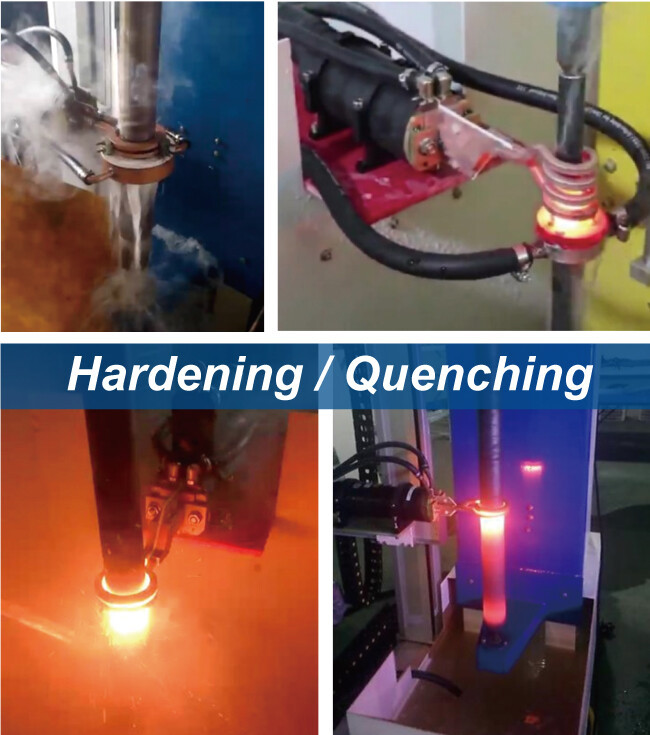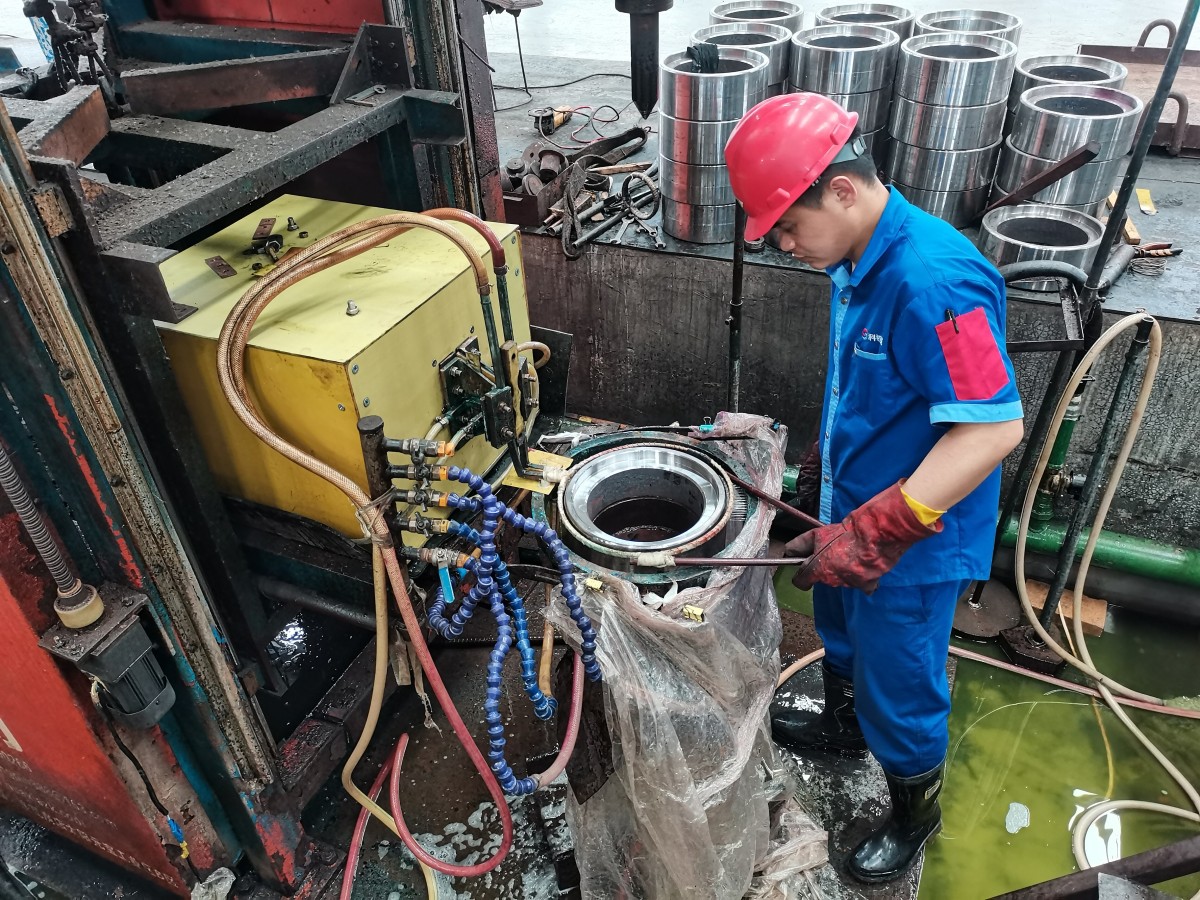
News
Induction heating in quenching utilizes electromagnetic fields to rapidly and uniformly heat metals, ensuring precise temperature control. This process enhances material hardness by transforming the metal's microstructure. Compared to traditional methods, induction heating offers unmatched efficiency and precision. Tools like the Induction Heating Equipment and the Quenching Heat Treating Machine provide consistent results, making them ideal for industrial applications. The Induction Heating Machine for quenching is particularly effective in achieving optimal heating outcomes, further solidifying its place in modern manufacturing processes.
Key Takeaways
Induction heating quenching offers rapid and precise heating, significantly enhancing material hardness while minimizing energy consumption by up to 95%.
Proper equipment setup and calibration are crucial for success; ensure the right induction heating machine is selected and regularly maintained for consistent results.
Accurate temperature control and monitoring are essential; utilize digital systems to manage energy delivery and track the cooling process to achieve desired mechanical properties.
Fundamentals of Induction Heating in Quenching

What is Induction Heating in Quenching?
Induction heating in quenching is a process that uses electromagnetic fields to heat metal parts rapidly and uniformly. This method relies on scientific principles such as electromagnetic induction, the skin effect, and magnetic hysteresis.
This process ensures that the surface of the material is heated while the core remains unaffected. The rapid cooling, or quenching, transforms the surface structure into a hardened layer, enhancing the material's durability and tensile strength.
Benefits of Induction Heating Quenching
Induction heating quenching offers several advantages over traditional methods.
This method minimizes energy consumption, saving up to 95% electricity compared to traditional techniques. It also ensures minimal deformation and oxide scale, resulting in superior material quality.
Applications of Induction Heating in Quenching
Induction heating in quenching is widely used across industries for its precision and efficiency. Common applications include:
Hardening of automotive components like gears, shafts, and crankshafts.
Heat treatment of machine tools and electric tools to enhance durability.
Surface hardening of steel parts to improve wear resistance.
Quenching of metal tubes and alloy cutters for industrial use.
This process is particularly effective for achieving a hardened surface while maintaining the core's toughness. By controlling the cooling rate and quenching medium, you can tailor the hardness and stress levels to meet specific requirements.
Step-by-Step Process for Induction Heating Quenching

Equipment Setup and Calibration
Proper equipment setup ensures the success of induction heating in quenching. Start by selecting the right induction heating equipment for your application. Machines like Canroon's High Frequency Induction Heating Equipment 60kw offer precise control and rapid heating capabilities. Position the workpiece correctly within the induction coil to achieve uniform heating. Calibrate the equipment to match the material's specific requirements, including power output and frequency. Regular calibration schedules for test equipment are essential to maintain accuracy and consistency. Written procedures covering all phases of the heat treatment process help ensure repeatable results.
Safety should remain a priority during setup. Provide operators with adequate personal protective equipment and comprehensive training programs. Regularly inspect the equipment to identify potential hazards, such as improper oil levels or ventilation system issues.
Temperature Control and Monitoring
Accurate temperature control is critical in induction heating quenching. Use a digital control system to precisely manage energy delivery to the part. Implement an independent monitoring system to track the process and ensure the material reaches the desired temperature. Mismanagement of temperature can lead to low hardness, poor mechanical properties, or even cracking. Maintain effective quality control systems to verify that the heating process meets specifications.
Monitor the quenchant to cool the part at the required rate. For example, water quenching offers rapid cooling, while oil quenching provides a slower rate, reducing the risk of distortion. Always follow written procedures and train operators to handle temperature-sensitive processes effectively.
Timing and Quenching Medium Selection
Timing plays a crucial role in achieving optimal results. The duration of heating and quenching directly impacts the material's hardness and durability. Use a timer to ensure precise control over the process. Select the quenching medium based on the material and desired properties. Common options include water, oil, and polymer solutions. Water quenching is ideal for rapid cooling, while oil quenching minimizes the risk of cracking. Polymer solutions offer a balance between speed and safety.
Consider safety measures when working with quenching mediums. For instance, oil quenching can pose fire hazards if the oil level is inadequate or overflows. Ensure proper ventilation and emergency response preparedness to mitigate risks. By carefully managing timing and medium selection, you can achieve consistent results in induction hardening.
Quality Control in Induction Heating Quenching
Hardness and Strength Testing
Testing the hardness and strength of materials after induction heating quenching ensures the process achieves the desired mechanical properties. You can use several standard methods to evaluate these parameters effectively:
Inspect hardness using tools like Rockwell or Shaw hardness testers.
Conduct metallographic examinations to analyze the microstructure and grain size.
Measure the depth of the hardened layer following GB5617 standards.
Check for deformation to confirm the material remains within tolerance limits.
Perform crack inspections using magnetic or fluorescent powder techniques.
For surface hardness, you can rely on Vickers or Rockwell hardness testers. For thicker hardened layers, the Leeb hardness tester provides accurate results when paired with the correct sensor. Typical hardness benchmarks vary by material. Medium to high-carbon steels often achieve 56-65 HRC, while 1045 steel can reach 58 HRC or higher. Lower carbon materials like 8620 typically range between 40-45 HRC.
Grain Structure Analysis
Grain structure plays a crucial role in determining the mechanical properties of materials treated with induction heating quenching. Fine or ultra-fine grains enhance hardness and reduce distortion. You can analyze grain structure using these techniques:
The prior microstructure, such as normalized or quenched and tempered structures, ensures a consistent response to induction hardening. This minimizes grain growth and improves residual stresses, resulting in superior mechanical performance.
Identifying and Resolving Defects
Defects can compromise the quality of induction heating quenching. Common issues include cracks, low hardness, and distortion. Cracks often result from overheating or rapid cooling, while low hardness may stem from inadequate heating or improper quenchant concentration. Misaligned coils or non-uniform quenching can lead to distortion.
To resolve these defects, you should:
Cool it at an appropriate rate to prevent cracks and achieve the desired hardness.
Add polymers to water to improve cooling properties and eliminate vapor barriers.
Adjust polymer concentration to control cooling speed and reduce material stresses.
By addressing these issues, you can ensure consistent results and enhance the durability of treated materials.
Induction heating offers unmatched efficiency and precision for quenching processes. Its ability to deliver rapid, localized heating ensures superior hardening results while minimizing energy consumption. Precision and quality control play a pivotal role in this process. Accurate energy delivery and controlled cooling directly influence the metallurgical properties of treated parts, ensuring consistent performance.
Adopting induction heating also benefits the environment. Its reliance on electricity instead of gas reduces emissions, while its energy efficiency can save up to 95% electricity compared to traditional methods. By integrating this advanced technology into your operations, you can achieve exceptional hardening results while contributing to sustainability.
FAQ
What is the main advantage of using induction heating for quenching?
Induction heating provides precise, localized heating, ensuring uniform temperature distribution. This minimizes energy waste and reduces the risk of material distortion during the quenching process.
Can induction heating be used for all types of metals?
Yes, induction heating works effectively on metals like steel, aluminum, and copper. However, the material's magnetic and electrical properties determine the efficiency of the process.
How do you ensure safety when using induction heating equipment?
Always wear protective gear and follow the manufacturer's guidelines. Regularly inspect the equipment for potential hazards, such as improper coil alignment or inadequate ventilation.
Please give us a message